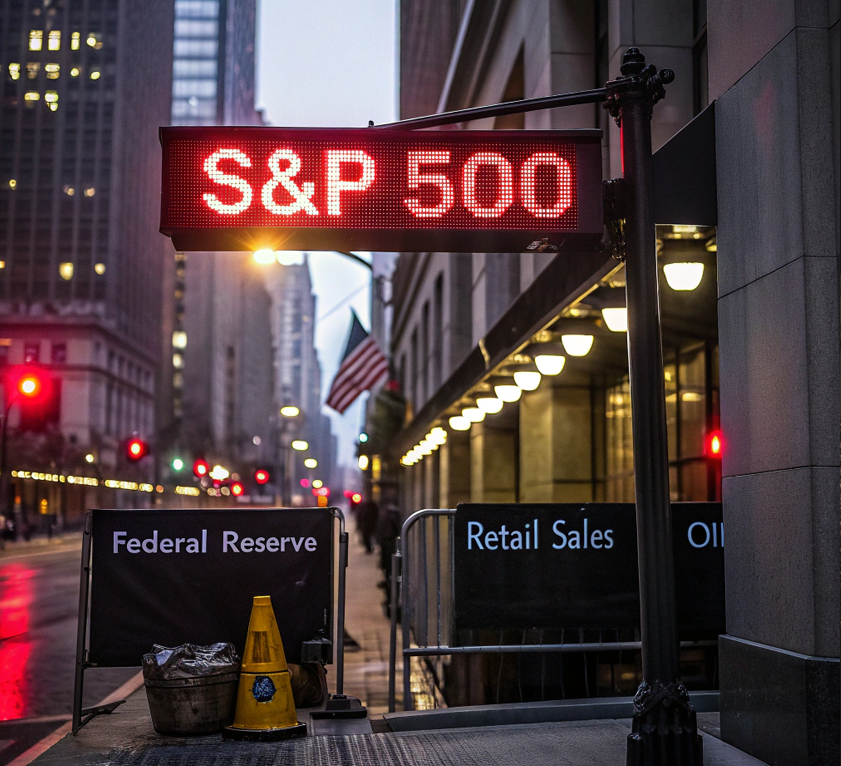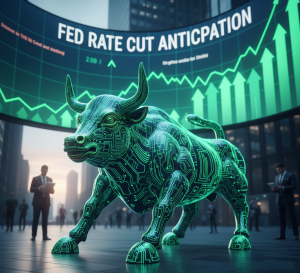The Day’s Narrative
U.S. stocks eased off record highs as traders waited for Wednesday’s Federal Reserve decision. The S&P 500 (-0.13%), Nasdaq (-0.07%), and Dow (-0.27%) all dipped, a sign of caution rather than stress. Treasury yields slipped the 10-year near 4.03% and 2-year ~3.51% while the U.S. dollar fell to a four-year low versus the euro, reflecting expectations for a quarter-point (25 bps) rate cut (a basis point is 0.01%). Oil settled higher on renewed risks to Russian supply.
The key data point indicated that consumers are still spending; August retail sales rose 0.6% month-over-month, and “core” sales increased 0.7% (core strips out autos, gasoline, building materials, and restaurants to better track everyday goods). These figures are not adjusted for inflation, so some of the rise may be higher prices, but they still show demand held up into the back-to-school season. That mix—steady spending but a softening labor market helps explain why investors expect a 25 bps cut: the Fed is trying to cushion slower growth without re-igniting inflation.
Company headlines showed how policy and geopolitics influenced single-stock movements. Oracle firmed up intraday on reports that it’s part of a U.S. investor group set to control most of TikTok’s U.S. business, a sign that a framework to keep the app running stateside is taking shape. By contrast, Nvidia slipped after a Reuters report stated that its new China-focused RTX 6000D AI chip has encountered tepid demand from major Chinese tech firms—an example of how export rules and local preferences can complicate the AI story.
Key Market Catalysts
- Consumer still spending (Retail Sales beat)
- What happened: August retail sales rose 0.6% m/m and core sales +0.7% (core excludes autos, gasoline, building materials, and restaurants to better isolate everyday goods). These figures are not inflation-adjusted, so part of the gain may reflect higher prices.
- Why it matters: The bear tempers fears of a rapid growth downshift and complicates hopes for aggressive easing if demand holds up, the Fed may feel less urgency to cut beyond the widely expected 25 bps. Category breadth also looked decent, consistent with back-to-school strength.
- Deal-watch: TikTok framework puts Oracle in focus
- What happened: A WSJ-flagged structure echoed by Reuters would see a U.S. consortium led by Oracle, Silver Lake and others controlling ~80% of TikTok’s U.S. business, with a separate U.S. app/stack and Oracle safeguarding U.S. user data; officials signaled a framework similar to one discussed in spring.
- Why it matters: A credible path to keeping TikTok operating in the U.S. reduces regulatory overhang for the company’s partners (like cloud providers) and keeps short-form ad dollars onshore, a modest plus for ad-tech and cloud adjacencies.
- AI jitters: Nvidia’s China chip gets a cold shoulder
- What happened: Reuters reported tepid demand from major Chinese tech firms for Nvidia’s new RTX6000D (a China-compliant AI chip reportedly around 50,000 yuan, or ~$7,000), with buyers seeing price/performance as unattractive versus alternatives. Nvidia shares eased on the headline.
- Why it matters: The AI trade has been market-leading; signs of demand frictions in China (amid export controls and local competition) challenge the “straight-line up” narrative and can add factor-level chop to semis and broader tech.
The Debate (The Bull vs. Bear Case)

The Bull Case: Resilient spending (retail sales +0.6%) suggests the consumer engine is still running, supporting revenues as rates drift lower. Easing yields and a weaker dollar loosen financial conditions, while firmer oil aids Energy sector earnings. Several outlets framed the pullback as a pause near records, not a trend change.

The Bear Case: Positioning and valuation risks loom. A Bank of America fund manager survey shows a record 58% calling stocks overvalued even as equity overweights tick up, leaving markets vulnerable to a hawkish surprise or soft guidance. Hedging flows highlight crowded “long Wall Street / short dollar” trades that could unwind if the Fed disappoints. Micro risk: Nvidia’s China chip demand wobble underscores fragility in AI-centric narratives. (P/E, or price-to-earnings, is price per share divided by earnings per share; high P/Es can compress if rates or growth disappoint.)
Next Session Outlook
All roads lead to Wednesday at 2:00 PM EDT. The market’s direction for the remainder of the week will be almost entirely dictated by the outcome of the FOMC meeting. Investors will pore over the official policy statement, the updated “dot plot” (which shows individual members’ expectations for future interest rates), and, most importantly, the nuances of Chairman Jerome Powell’s language during his post-announcement press conference. Any signal of sustained hawkishness could trigger a further sell-off, while a more balanced or unexpectedly dovish tone could spark a significant relief rally.
Disclaimer: This article is for informational purposes only and does not constitute financial, investment, or legal advice. The information provided is a synthesis of publicly available data and expert analysis and should not be considered a recommendation to buy or sell any security. Investing in the stock market involves risk, including the possible loss of principal. Past performance is not indicative of future results. Readers should consult with a qualified financial advisor to determine an investment strategy that is suitable for their own personal financial situation and risk tolerance.






















